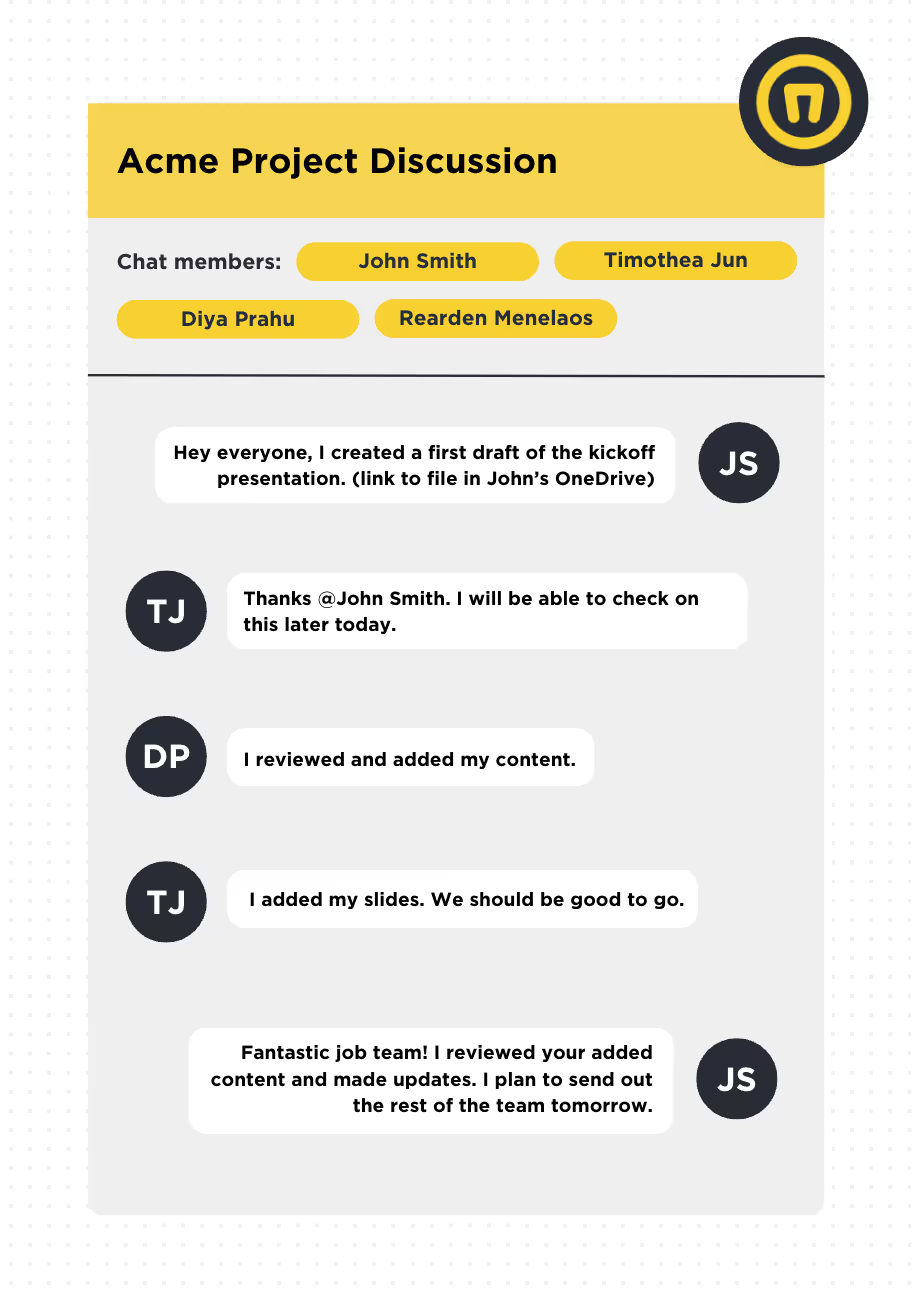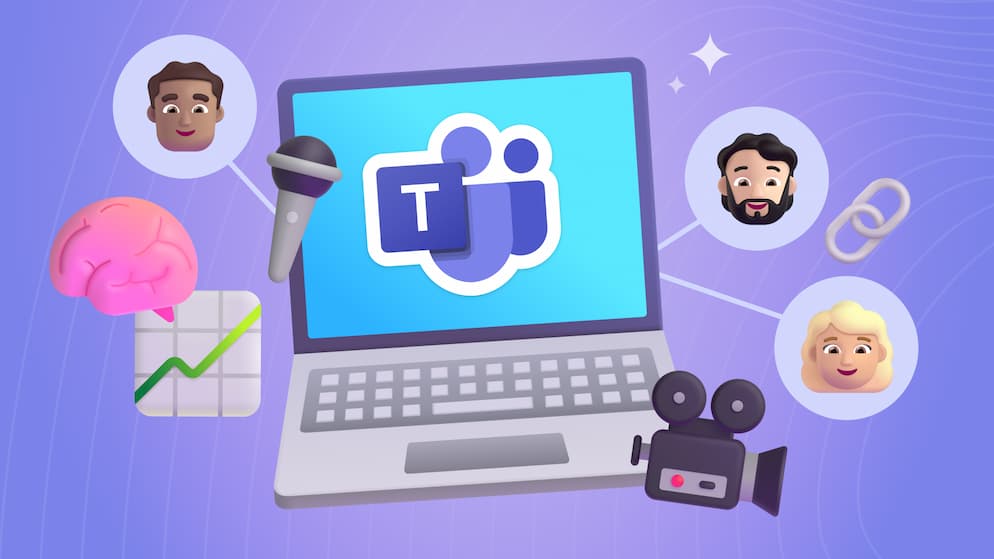Cultivate Better Communication and Collaboration with Topics
Organizing communication might not be at the top of your list when it comes to workplace priorities, but it should! In today's blog we're going to break down what topic-based communication and collaboration is and why it's benefical for any company.
Intro
Most of us don’t spend much time considering how we organize our communication and collaboration beyond what makes the most personal sense to us. This often creates a very people-based approach, which typically doesn’t work well in a team setting. We are going to talk about why this can be a problem and how you can change this mindset to level up your communication and collaboration.
What Do We Mean by “People-Based” Approach?
It might seem silly to be talking about communicating in a way that is not people-based. We are all people after all, and the people are what is important.
What we are talking about is the mindset and method we are using when we are communicating or collaborating. By people-based, we mean when you’re creating a new message at work, it’s common for the first thing you think of to be “I need to send a message to Sally and Dave”.
This might be hard to conceptualize so let’s use a common example to help illustrate what we mean.

Ask yourself what the first thing you would enter if you were John creating this email. I am willing to bet it was who this would go to (Timothea, Diya, Rearden). This is one of the key characteristics of person-based communication and collaboration. Who you are messaging is prioritized over everything else.
The first example should be obvious to anyone who is a heavy user of email. What about users who primarily use chat?

Again, what was the first thing John had to do to start this chat group? You guessed it, the people they wanted to include. This is still person-based because:
- It's from one person to one or more people.
- The technology used is inherently personal in nature (email, text message, OneDrive, direct chat)
- The context/topic needs to be articulated in the message.
Why is Person-Based Communication and Collaboration a Problem?
Not all person-based communication and collaboration is bad, but the vast majority isn’t great. It creates the following common problems.
Problem #1: Each individual owns the data and is responsible for managing it
When you send an email, that email lives in your individual mailbox as sent mail. Everyone you sent that email to receives a copy of that message in their individual mailbox as a received mail. What happens to these messages happens at either a message level or a person level.
- If you decide to delete it, you can.
- If you decide to keep it, you can.
- If you leave the organization, your mailbox will likely be deleted and with it all your messages.
This is fine for messages that are truly individual. If you think more deeply about the messages you send, you’re likely to find most are NOT individual in nature.
While my example is email, the same can be said for text messaging, chats, etc.
Problem #2: It's up to the recipients to categorize and organize the messages
When you send messages to a person, they have little to no way to distinguish them from any other message they receive. This is why we often focus on using good subject lines in emails or starting a chat message with context to let the person receiving the message understand the context.
This is also why users create automated rules to move emails into folders, tag, highlight, or otherwise organize their mailbox. The more messages you receive, the worse this is. This also leads to a desire to leave people off messages so they will not be bothered or overwhelmed.
Problem #3: There is no way to “opt-in” to the conversation
Sending messages to a person will notify that person no matter what. What if they just need to be able to get the information if they need it? You are now in a situation where you must send things to them because they won’t be able to find it if it’s not in their mailbox or chat history. What you really want is to simply give ACCESS to the shared discussion so they can get it if they need it.
Think about the last time that someone forgot to CC someone on an email thread and you try to add them in. Someone else replies to the original message and that person is out of the loop again. This type of thing happens all the time when we use person-based communication and collaboration.

SELF ASSESSMENT
Is your business getting full value from your M365 subscription?
Billions of dollars are wasted each year on underused subscriptions. Take 3 minutes to find out where your tools are driving results, and where they’re holding you back.
Find Out Now

Is Team Communication Holding You Back?
Find Out in Just 2 Minutes.
Take our quick scorecard to uncover communication gaps and hidden barriers within your team.
Topic-Based Communication and Collaboration Can Help 🙌
The good news is, there is another way, and there are tools out there that make it easy. Topic-based communication and collaboration is an alternative way to think about how you work with others. It deprioritizes the individuals you are working with and puts the topic at the center. This means the first thing you need to consider is the topic and not who you’re sending a message to. The topic is important and should dictate how you should send the message.
Since we are only talking about “how we think about working with others”, can’t we still use the same tools we have been using? Yes, but it’s rather difficult. A lot of the common tools (like email) aren’t built to focus on topic and are built to focus on people. Think about email, chat, text message, or even snail mail: the first thing you articulate is who you are messaging with, not what you are messaging about. There is a reason these tools have you fill in the “To” before the subject. The person is king.
We want to switch this so the first thing we think about is what topic this best fits into. Is this about finance? Is this about operations? Marketing? These are much better questions to ask first. Doing this will allow us to select the proper place to send the message. If that place is natively supported by the tools you use and everyone does this, it can transform how you work.
Let’s take the example we started with:

You will notice, the actual text of the discussion is the same as the group chat example I provided. The difference is that this is all happening in the context of a Team that is focused on the project in question. The channel has a bunch more people on it, but they are not being tagged in the discussion that is going on between the collaborators.
This approach resolves the problems created by person-based communication and collaboration.
- The data is owned by the team not the individual. People can come and go over time and the data lives on.
- The information inherently has categories (Team and Channel), and these categories are consistent and manageable.
- Only the people directly tagged will need to read the messages. Everyone else can read if they want to. This creates a sort of self-service situation where people can prioritize certain topics over others, and always get notifications if someone tags them directly.
You might be thinking I am saying Teams is the only way to do this. I am not. Modern tools provide a topic-based approach to communication and collaboration. Slack and SharePoint are probably my other two favorite tools when it comes to topic-based communication and collaboration. But you can do similar things using Email using shared mailboxes. It’s just not easy, because email was not created around this concept, it was created around people 🙄
This Doesn't Mean Person-Based Messaging Isn't Valid
There are a bunch of scenarios where person-based messaging is still right. If you’re having a discussion that is personal in nature or there isn’t a suitable topic-based location, it's completely fine to use a person-based messaging approach.
It’s also common for users who are only loosely connected or do not work together often to continue using a person-based approach. It's easier and doesn’t require as much setup. The more often you have person-based communication and collaboration with one or more users, the more likely you should really move to a topic-based approach.
It Isn’t All Rainbows and Unicorns...
We believe in topic-based communication and collaboration. It’s the way we communicate and collaborate internally. It’s also how we strive to collaborate with our customers. At the same time, we are not blind to the challenges with using this type of communication approach. We simply feel the benefits greatly outweigh the challenges.
Here’s a few common complaints we hear/see:
- Users need to understand how to use Topic-based tools (when they probably already know how to use email).
- Most topic-based tools are “chattier”, so managing notifications is important.
- Permissions must be managed as opposed to someone being able to send email messages to anyone anytime.
- The spread of information can be challenging for them to wrap their arms around. It isn’t as “simple” as searching their mailbox for an email.
There are obvious tactical things you can do to address these. Like, train users on how to use the tools and communicate what you are trying to do so everyone is on the same page. But for us, this is part of a broader transformation for businesses.
What Are Straightforward Ways to Get Started?
Changing how an organization communicates is hard. The best way to get started is to ask yourself the following questions before you send an email, direct chat, or other message.
- Is there a topic-based location you could send the message to?
- If not, should there be one?
- If there is, why would you not send the message there?
If you still plan to send a person-based message, ask yourself what would have to change to be able to send using a topic-based approach. You should be able to use a topic-based approach at least some of the time by choosing one project or team to try it out with. It is Okay if you start small.
Another common challenge is dealing with messages that you are responding to instead of creating. It’s much more difficult when someone else starts the conversation in the wrong place.
✅ The best approach to convert the discussion is:
- Copy the message and any attachments into the topic-based location.
- Message in the topic-based location explaining that you are moving the discussion here to make things easier.
- Respond to the person-based message including a link to the topic-based location.
- Offer to help anyone who doesn’t know how to use the topic-based location.
🚫 Things you shouldn’t do:
- Be a jerk while redirecting the conversation
- Expect this to be the last time you must do this.
- Put the message in a topic-based location that some people don’t have access to.
Conclusion
Topic-based communication and collaboration is something we are passionate about and isn’t easy to explain without having someone see the impact it can have. Once you start down this path and see how transformative it can be, we don’t think you will ever turn back. Reach out and let us know how your organization communicates based on topic instead of people.







.jpg)







